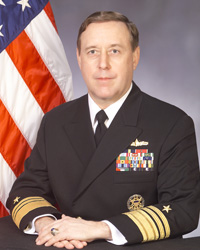
USS Bunker Hill (CG-52) is a Ticonderoga-class guided missile cruiser of the United States Navy constructed by Litton-Ingalls Shipbuilding Corporation at Pascagoula, Mississippi and launched on 11 March 1985. The Ticonderoga-class cruisers are equipped with the Aegis Combat System and Bunker Hill is the first of the class to be equipped with the Mark 41 Vertical Launching System (VLS) in place of the previous ships' twin-arm Mark 26 missile launchers, which greatly improved the flexibility and firepower of the ships by allowing them to fire BGM-109 Tomahawk cruise missiles for land attack missions. Other missions include ballistic missile defence and capital ship escort for anti-aircraft defense. The ship was commissioned on 20 September 1986 and is homeported at Naval Base San Diego in San Diego, California.

USS Mobile Bay (CG-53) is a Ticonderoga class guided-missile cruiser serving in the United States Navy. She is named for the naval Battle of Mobile Bay during the American Civil War in 1864.
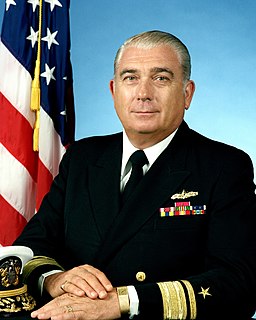
Robert Theodore Reimann Sr. was a U.S. Navy rear admiral. Born in Cambridge, Massachusetts, he graduated from the Boston University College of Business Administration in 1958. He then attended the Officer Candidate School at Newport, Rhode Island, and was commissioned into the United States Naval Reserve as an ensign on May 1, 1959.

Gary Roughead is a former United States Navy officer who served as the 29th Chief of Naval Operations from September 29, 2007 to September 22, 2011. He previously served as Commander, United States Fleet Forces Command, from May 17 to September 29, 2007. Prior to that, Roughead served as the 31st Commander, United States Pacific Fleet from July 8, 2005, to May 8, 2007. He retired from the U.S. Navy after 38 years of service.

USS Richmond K. Turner was a Leahy-class cruiser destroyer leader in the United States Navy. The ship was named for Admiral Richmond K. Turner, who served during World War II.

The first USS Halsey, a Leahy-class guided missile cruiser was a ship of the United States Navy named in honor of Fleet Admiral William Halsey. Originally called a destroyer leader or frigate (DLG-23), on 30 June 1975 she was redesignated a cruiser (CG-23) in the U.S. Navy's ship reclassification.

Rear Admiral Wayne Eugene Meyer is regarded as the "Father of Aegis" for his 13 years of service as the Aegis Weapon System Manager and later the founding project manager of the Aegis Shipbuilding Project Office. He retired from the United States Navy in 1985 as the Deputy Commander for Weapons and Combat Systems, Naval Sea Systems, Naval Sea Systems Command and Ordnance Officer of the Navy.

Rear Admiral Paul Edward Tobin Jr., United States Navy, served as Oceanographer of the Navy from 1996 to 1998 and Director of Naval History from 2005 to 2008.

Joseph Metcalf III was a United States Navy vice admiral. He graduated from the Naval Academy in 1951 and retired from active duty in 1987.

Richard Wayne Hunt is a United States Navy vice admiral who served as Director - Navy Staff. He retired from active duty in November 2013.

Thomas Henry Copeman III is a retired officer of the United States Navy. In mid-2009 he was appointed commandant of the Guantanamo Bay detention camps, in Cuba.
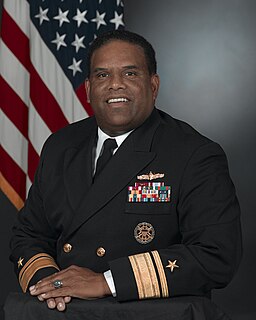
Victor G. Guillory is a retired United States Navy rear admiral who, in his last position, served as the Commander, United States Fourth Fleet.

Derwood Clayiborne Curtis is a retired vice admiral in the United States Navy who served as the Commander, Naval Surface Forces and concurrently Commander, Naval Surface Force, U.S. Pacific Fleet from February 2008 to June 2011.
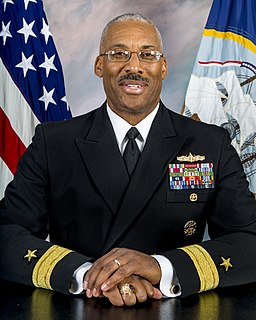
Rear Admiral Jesse Alphonzo Wilson Jr. is a retired United States Navy officer. His last active duty assignment was as commander of Naval Surface Force Atlantic.

James P. "Phil" Wisecup is a retired United States Navy vice admiral, who last served as the 38th Naval Inspector General. Prior to that, he served as the president of the Naval War College. Since October 2013, he has been director of the Chief of Naval Operations Strategic Studies Group.

Lee Fredric Gunn is a retired Vice Admiral and former Naval Inspector General of the United States Department of the Navy.
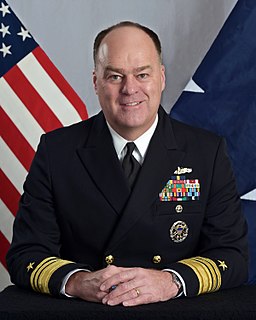
John Nels Christenson is a retired vice admiral in the United States Navy who last served as the United States Military Representative to the NATO Military Committee, in Brussels, Belgium. He was the 53rd President of the Naval War College in Newport, Rhode Island from March 2011 to July 2013.
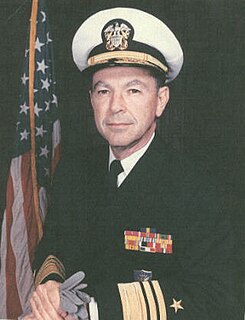
Julien Johnson LeBourgeois was a retired vice admiral of the United States Navy. His career included service in World War II, the Cold War, and the Vietnam War, duty aboard and command of cruisers and destroyers, various planning and staff assignments, and a tour as President of the Naval War College.

Jacob Lawrence Shuford was a rear admiral of the United States Navy. His career included service in the Cold War, Kosovo War, and Operation Desert Fox. He commanded surface combatants, served on the staffs of the Chief of Naval Operations, the Joint Chiefs of Staff, and the Secretary of the Navy, coordinated Navy legislative activities in the United States Senate, and his final assignment as President of the Naval War College.
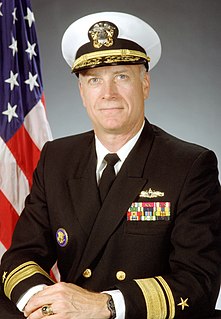
James R. Stark is a retired rear admiral of the United States Navy who served during the Cold War and in the Vietnam War and oversaw operations related to the Yugoslav Wars of the 1990s. A surface warfare officer, his career included command of ships at sea, senior U.S. Navy and North Atlantic Treaty Organization (NATO) commands, staff assignments with the Chief of Naval Operations and the National Security Council, and a tour as President of the Naval War College.
